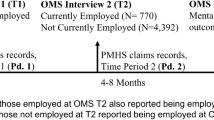Abstract
Employment among persons with severe mental illness has been challenging. Supported employment programs have had some success; however, much remains to be understood about client motivations for employment. A labor force participation study was mailed to persons receiving services in a Midwestern state’s publicly funded behavioral health system, and a random sample of participants resulted in 964 valid surveys. Analysis showed significant differences between Medicaid coverage program and labor force status, with some programs likely to have higher percentages of employed persons. A multinomial logistic regression model explored the odds of employment and unemployment to not being in the labor force. Perception of incentives to employment greatly increased the odds, while age and perception of barriers to employment decreased the odds for both groups when compared to those not in the labor force. Findings have implications for the design of employment programs and coverage benefits.
Similar content being viewed by others
References
Goldstrom ID, Manderscheid RW. The Chronically Mentally Ill: A Descriptive Analysis from the Uniform Client Data Instrument. Community Support Service Journal. 1982;23:4–9.
Mulkern VM, Manderschied RW. Characteristics of Community Support Program Clients in 1980 and 1984. Hospital and Community Psychiatry. 1989;40(2):165–172.
Anthony WS, Jansen M. Predicting the Vocational Capacity of the Chronically Mentally Ill. American Psychologist. 1984;39:537–544.
Uttaro T, Mechanic D. The NAMI Consumer Survey Analysis of Unmet Needs. Psychiatric Services. 1994;45(4):273–374.
Roth D, Crane-Ross D, Hannon MJ, et al. Toward Best Practices: Top Ten Findings from the Longitudinal Consumer Outcomes Study. Columbus Ohio Department of Mental Health, Office of Program Evaluation & Research, 1999.
Bonnie RJ, Monahan J. Mental Disorder, Work Disability, and the Law. Chicago: University of Chicago Press, 1997.
Estroff SE, Zimmer C, Lachicotte WE, et al. Pathways to Disability Income Application among Persons with Severe Persistent Mental Illness. The Millbank Quarterly. 1997;75(4),495.
Substance Abuse and Mental Health Services Administration. Achieving the Promise: Transforming Mental Health Care in America, Final Report. HHS Publication No. SMA 03–3832, Rockville: Department of Health and Human Services, 2003.
Cook JA. Employment Barriers for Persons with Psychiatric Disabilities: Update of a Report for the President’s Commission. Psychiatric Services. 2006;57(20):1391–1405.
Cook JA. One-Year Follow-Up of Illinois State Vocational Rehabilitation Clients with Psychiatric Disabilities Following Successful Closure into Community Employment. Journal of Vocational Rehabilitation. 2003;18:25–32.
Drake RE, Skinner JS, Bond GR et al. Social Security and Mental Illness: Reducing Disability with Supported Employment. Health Affairs. 2009;28(3),761–770.
Lehman AF. Vocational Rehabilitation in Schizophrenia. Schizophrenia Bulletin. 1995;21:645–656.
Bond GR, Drake RE. Predictors of Competitive Employment among Patients with Schizophrenia. Current Opinion in Psychiatry. 2008;21(4):362–269.
Bond GR, Drake RE, Becker DR. An Update on Randomized Controlled Trials of Evidence-Based Supported Employment. Psychiatric Rehabilitation Journal. 2008;31(4):280–290.
Wewioriski JH, Fabian ES. Association between Demographic and Diagnostic Factors and Employment Outcomes for People with Psychiatric Disabilities: A Synthesis of Research. Mental Health Services Research. 2004;6(1):9–21
Burke-Miller JK, Cook JA, Grey DD, et al. Demographic Characteristics and Employment among People with Severe Mental Illness in a Multisite Study. Community Mental Health Journal. 2006;42(2):143–159.
Corbiere M, Mercier C, Lesage A. Perceptions of Barriers to Employment, Coping Efficacy, and Career Search Efficacy in People with Mental Illness. Journal of Career Assessment. 2004;12:460–478.
Salyers MP, McGuire AB, Bond GR, et al. What Makes the Difference? Practitioner View of Success and Failure in Two Effective Psychiatric Rehabilitation Approaches. Journal of Vocational Rehabilitation. 2008;28:105–114.
Bickhard MH. An Integration of Motivation and Cognition. Development and Motivation: Joint Perspectives. 2003;41–56.
Beck JS. Cognitive Therapy: Basics and Beyond. New York: Guilford Press, 1995.
Miller WR, Rollnick S. Motivational Interviewing, Second Edition. New York: Guildford Press, 2002.
Ryan RM, Deci EL. Intrinsic and Extrinsic Motivations. Classic Definitions and New Directions: Contemporary Educational Psychology. 2000;25(1):54–67.
Larson JE, Ryan CB, Wassel AK, et al. Analysis of Employment Incentives and Barriers for Individuals with Psychiatric Disabilities. Rehabilitation Psychology. 2011;56(2):145–149.
Dantzker ML, Hunter RD. Research Methods for Criminology and Criminal Justice, Third Edition. Sudbury: Jones & Bartlett Learning, 2012.
Substance Abuse and Mental Health Services Administration. Combined Substance Abuse and Mental Health Treatment Episode Data Set (TEDS) State Instruction Manual with State TEDS Submission System (STSS, Version 4.0) Guide. Center for Behavioral Health Statistics and Quality. Available online at https://wwwdasis.samhsa.gov/dasis2/manuals/Combined%20SA%20and%20MH%20TEDS%20Manual%20V4.2_6-1.pdf. Accessed on July 2, 2015.
Bureau of Labor Statistics. BLS Handbook of Methods, Chapter 4: Measurement of Unemployment in States and Local Areas. U.S. Department of Labor. Available online at http://www.bls.gov/opub/hom/. Accessed on July 2, 2015 2015.
Jerrell JM. Psychometrics of the MHSIP Adult Consumer Survey. Journal of Behavioral Health Services and Research. 2006;33(4):483–488.
Hosmer D, Lemeshow S. Applied Logistic Regression, Second Edition. New York: Wiley, 2000.
The Analysis Factor. How to Diagnose the Missing Data Mechanism. Statistical Resources. Available online at http://www.theanalysisfactor.com/missing-data-mechanism/. Accessed on July 1, 2015.
Pigott TD. A Review of Methods for Missing Data. Educational Research and Evaluation. 2001;7(4):353–383.
Alderks CE, Lutterman T, Phelan B, et al. June 15, 2015 Webinar of the 2014 Mental Health Data Collection Results URS, MH-CLD, MH-TEDS. The Behavioral Health Services Information System. Available online at https://bhsisresourcecenter.smdi.com/system/files/ADAWT/SAMHSA/2014_Mental_Health_Data_Collection_Results-Webinar_Slides_June_15.pdf. Accessed on July 14, 2015.
Author information
Authors and Affiliations
Corresponding author
Ethics declarations
Conflict of Interest
The authors declare that they have no competing interests.
Rights and permissions
About this article
Cite this article
Carstens, C., Massatti, R. Predictors of Labor Force Status in a Random Sample of Consumers with Serious Mental Illness. J Behav Health Serv Res 45, 678–689 (2018). https://doi.org/10.1007/s11414-018-9597-8
Published:
Issue Date:
DOI: https://doi.org/10.1007/s11414-018-9597-8




